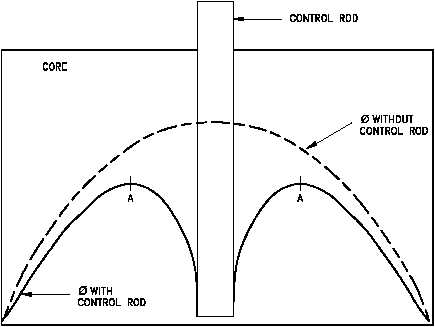CONTROL RODS
DOE-HDBK-1019/2-93
Reactor Theory (Nuclear Parameters)
Not all reactors have different control rods to serve the purposes mentioned above. Depending
upon the type of reactor and the controls necessary, it is possible to use dual-purpose or even
triple-purpose rods. For example, consider a set of control rods that can insert enough reactivity
to be used as shim rods. If the same rods can be operated at slow speeds, they will function as
regulating rods. Additionally, these same rods can be designed for rapid insertion, or scram.
These rods serve a triple function yet meet other specifications such as precise control, range of
control, and efficiency.
Control Rod Effectiveness
The effectiveness of a control rod depends largely upon the value of the ratio of the neutron flux
at the location of the rod to the average neutron flux in the reactor. The control rod has
maximum effect (inserts the most negative reactivity) if it is placed in the reactor where the flux
is maximum. If a reactor has only one control rod, the rod should be placed in the center of the
reactor core. The effect of such a rod on the flux is illustrated in Figure 8.
If additional rods are added to this simple reactor, the most effective location is where the flux
Figure 8 Effect of Control Rod on Radial Flux Distribution
is maximum, that is, at point A. Numerous control rods are required for a reactor that has a
large amount of excess reactivity (that amount of reactivity in excess of that needed to be
critical). The exact amount of reactivity that each control rod inserts depends upon the reactor
design. The change in reactivity caused by control rod motion is referred to as control rod
worth.
NP-03
Rev. 0
Page 50

